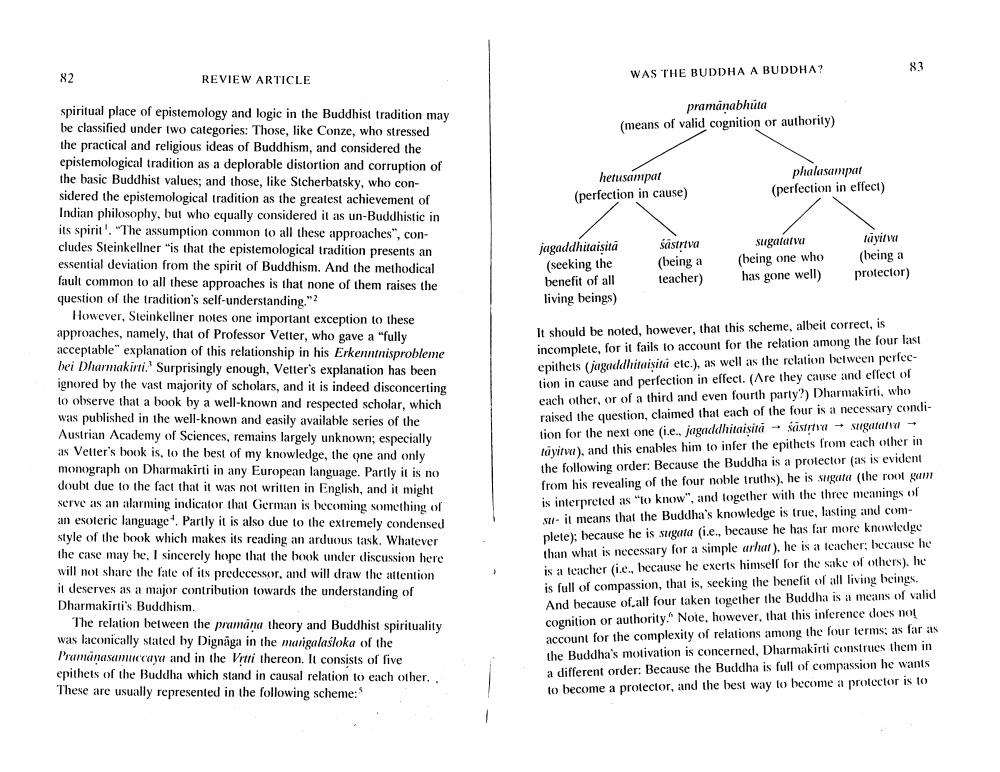Book Title: was The Buddha A Buddha Author(s): Eli Franco Publisher: Eli Franco View full book textPage 2
________________ REVIEW ARTICLE WAS THE BUDDHA A BUDDHA? pramanabhūta (means of valid cognition or authority) hetusampat (perfection in cause) phalasampal (perfection in effect) jagaddhitaisita (seeking the benefit of all living beings) śāststva (being a teacher) sugatarwar (heing one who has gone well) tayitva (heing a protector) spiritual place of epistemology and logic in the Buddhist tradition may be classified under two categories: Those, like Conze, who stressed the practical and religious ideas of Buddhism, and considered the epistemological tradition as a deplorable distortion and corruption of the basic Buddhist values and those, like Stcherbatsky, who considered the epistemological tradition as the greatest achievement of Indian philosophy, but who equally considered it as un-Buddhistic in its spirit'. "The assumption common to all these approaches", concludes Steinkellner is that the epistemological tradition presents an essential deviation from the spirit of Buddhism. And the methodical fault common to all these approaches is that none of them raises the question of the tradition's self-understanding." However, Steinkellner notes one important exception to these approaches, namely, that of Professor Vetter, who gave a "fully acceptable" explanation of this relationship in his Erkenntnisprobleme bei Dharmakirti. Surprisingly enough, Vetter's explanation has been ignored by the vast majority of scholars, and it is indeed disconcerting to observe that a book by a well-known and respected scholar, which was published in the well-known and easily available series of the Austrian Academy of Sciences, remains largely unknown, especially as Veller's book is, to the best of my knowledge, the one and only monograph on Dharmakirti in any European language. Partly it is no doubt due to the fact that it was not written in English, and it might serve as an alarming indicator that German is becoming something of an esoteric language". Partly it is also due to the extremely condensed style of the book which makes its reading an arduous task. Whatever the case may be. I sincerely hope that the book under discussion here will not share the fate of its predecessor, and will draw the attention it deserves as a major contribution towards the understanding of Dharmakirti's Buddhism. The relation between the pramana theory and Buddhist spirituality was laconically stated by Dignaga in the munigalasloka of the Prumanasemliccaya and in the Viri thereon. It consists of five epithets of the Buddha which stand in causal relation to each other.. These are usually represented in the following scheme: It should be noted, however, that this scheme, albeit correct, is incomplete, for it fails to account for the relation among the four last epithets (jagaddhilişiti etc.), as well as the relation between perfeetion in cause and perfection in effect. (Are they cause and ellect of each other, or of a third and even fourth party?) Dharmakirli, who raised the question, claimed that each of the four is a necessary condition for the next one (i.e.. jagaddhitaisitii - siste sig layirve), and this enables him to infer the epithets from each other in the following order: Because the Buddha is a protector (as is evident from his revealing of the four noble truths), he is sugula (the root game is interpreted as to know", and together with the three meanings of su- it means that the Buddha's knowledge is true, lasting and complete): because he is sugata (i.e., because he has far more knowledge than what is necessary for a simple arhar), he is a teacher: because he is a teacher (ie, because he exerts himself for the sake of others). he is full of compassion, that is, secking the benefit of all living beings. And because of all four taken together the Buddha is a means of valid cognition or authority." Nole, however, that this inference does not account for the complexity of relations among the four terms as far as the Buddha's motivation is concerned, Dharmakirti construes them in a different order: Because the Buddha is full of compassion he wants to become a protector, and the best way to become a protector is toPage Navigation
1 2 3 4 5 6 7 8 9 10
